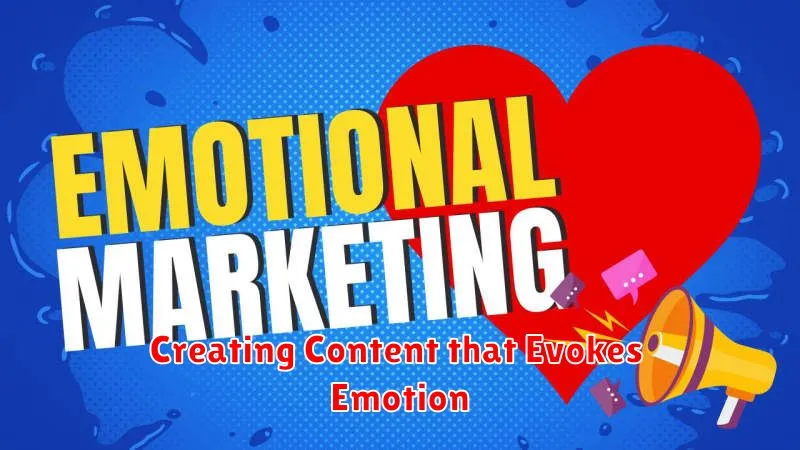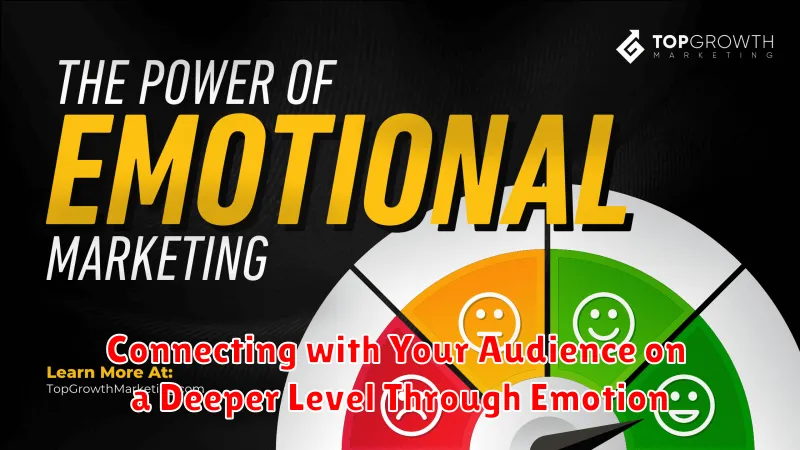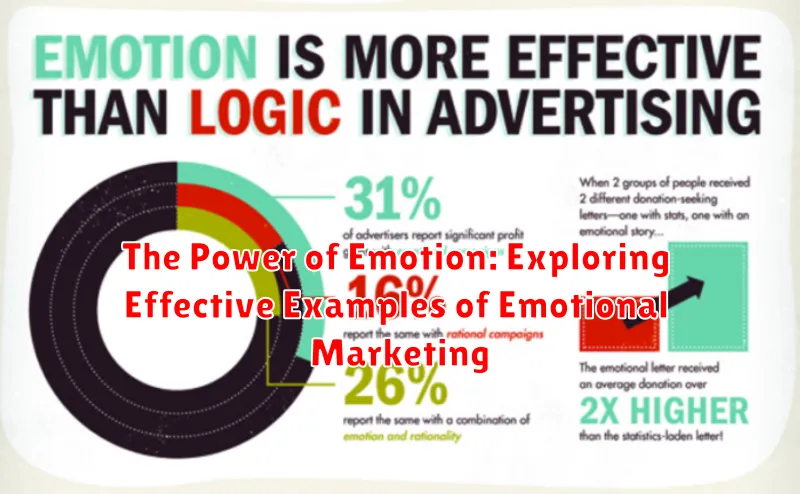In the competitive landscape of modern business, emotional marketing has emerged as a powerful tool for connecting with consumers on a deeper level. This approach leverages the power of emotion to resonate with audiences, fostering brand loyalty and driving purchasing decisions. This article delves into the realm of emotional marketing, exploring effective examples of how brands successfully tap into human feelings to create impactful campaigns. We will analyze the strategies behind these successful campaigns, highlighting the key elements that make them effective in influencing consumer behavior. Understanding the nuances of emotional marketing is crucial for any business seeking to establish a meaningful connection with its target audience.
Beyond simply selling products or services, effective emotional marketing aims to cultivate genuine relationships with consumers by evoking powerful emotions. From joy and nostalgia to empathy and inspiration, understanding the spectrum of human feeling allows marketers to craft targeted messages that resonate deeply. Through effective examples, this article demonstrates the practical application of emotional marketing principles, offering valuable insights for businesses looking to enhance their marketing strategies. We will examine how brands use storytelling, visuals, and other creative techniques to elicit specific emotions and create a lasting impact on their audience, ultimately showcasing the power of emotion in driving business success.
Understanding the Psychology Behind Emotional Marketing
Emotional marketing leverages the power of emotions to connect with consumers on a deeper level. It moves beyond simply promoting features and benefits, instead focusing on creating a resonant experience. This approach recognizes that purchasing decisions are often influenced by feelings rather than logic.
By tapping into specific emotions, marketers can influence consumer behavior, build brand loyalty, and foster stronger connections. Understanding the psychology behind this approach is crucial for crafting effective campaigns.
How Emotions Influence Decisions
Emotions play a significant role in the decision-making process. They act as mental shortcuts, guiding choices and shaping perceptions. Positive emotions can create positive associations with a brand, while negative emotions can lead to avoidance.
The Role of Memory
Emotional experiences are more memorable than factual information. By creating emotionally charged content, marketers can increase the likelihood that their message will be remembered and have a lasting impact.
Types of Emotions Used in Marketing and Their Impact
Emotional marketing leverages a range of human emotions to connect with consumers on a deeper level. Understanding the nuances of these emotions and their potential impact is crucial for crafting effective campaigns.
Happiness is often employed to associate positive feelings with a brand or product. This can lead to increased brand affinity and purchase intent. Sadness, while seemingly counterintuitive, can be used effectively to foster empathy and create a sense of shared experience. Think of charitable campaigns that tug at the heartstrings.
Fear, used cautiously, can highlight the negative consequences of not using a product or service. Security systems or insurance often employ this tactic. Anger can be channeled to rally support for a cause or against a competitor, but requires careful handling to avoid alienating potential customers. Finally, surprise can generate excitement and buzz, making a brand memorable.
Building a Strong Brand Narrative that Resonates Emotionally
A compelling brand narrative is crucial for forging a strong emotional connection with consumers. It goes beyond simply stating what a product or service does; it delves into the why behind the brand’s existence. This narrative should articulate the brand’s values, mission, and the problem it solves for its target audience.
Crafting an effective brand narrative involves understanding your ideal customer’s aspirations, pain points, and motivations. By aligning your narrative with these emotional drivers, you create a sense of resonance and belonging. This resonates deeply with consumers and fosters brand loyalty.
Consider incorporating elements of authenticity and vulnerability into your narrative. Sharing the brand’s origin story or highlighting the challenges overcome along the way humanizes the brand and makes it more relatable. This fosters trust and strengthens the emotional bond with the audience.
Consistency in messaging across all platforms reinforces the brand narrative and strengthens its impact.
Creating Content that Evokes Emotion

Effective emotional marketing hinges on content that resonates deeply with the target audience. This involves understanding the nuances of emotional triggers and how they can be incorporated into various content formats.
Consider leveraging storytelling. Narratives create a connection by presenting relatable situations and characters that embody specific emotions. This allows the audience to see themselves within the story, strengthening the emotional impact.
Sensory language is also key. By using descriptive words that appeal to the senses, content can evoke stronger emotional responses. Think about how certain words can trigger memories or create visceral reactions.
Finally, consider the format of your content. Video can be highly effective for conveying complex emotions through visuals and sound. Written content can utilize powerful metaphors and imagery. The chosen format should align with the specific emotion you wish to elicit.
Examples of Emotional Marketing Campaigns Across Different Industries
Examining successful campaigns provides valuable insights into the practical application of emotional marketing. Across various industries, brands leverage different emotions to connect with their target audience.
Technology: Nostalgia and Connection
A prominent tech company launched a campaign centered around the theme of reconnecting with loved ones. The advertisements showcased heartwarming stories of families using their products to bridge distances and strengthen bonds, evoking feelings of nostalgia and belonging.
Food and Beverage: Joy and Shared Experiences
A popular beverage brand consistently uses themes of joy and shared experiences in its marketing. Their campaigns often feature groups of friends and families enjoying life’s simple pleasures, associating their product with positive emotions and social connection.
Automotive: Safety and Security
Car manufacturers often tap into emotions related to safety and security. Their advertisements frequently portray families protected in their vehicles, emphasizing the importance of reliable transportation and peace of mind.
Measuring the Effectiveness of Emotional Marketing Campaigns
Gauging the success of emotional marketing initiatives requires a nuanced approach that goes beyond traditional metrics. While sales figures and website traffic provide some insight, they don’t fully capture the impact on consumer sentiment and brand perception. Measuring emotional engagement requires assessing qualitative and quantitative data.
Quantitative methods can include analyzing social media engagement (shares, comments, likes), brand mentions, and changes in website traffic following an emotional campaign. Surveys and questionnaires can also provide structured data on customer attitudes and purchase intent. Tracking these metrics helps to understand the immediate impact of a campaign.
Qualitative data offers deeper insights into consumer responses. Focus groups and in-depth interviews allow marketers to explore the nuances of emotional reactions. Sentiment analysis tools can help gauge the overall emotional tone of online conversations surrounding a brand or campaign. These methods reveal the “why” behind the quantitative data.
Ethical Considerations in Emotional Marketing
While emotional marketing can be a powerful tool, it’s crucial to wield it responsibly. Ethical considerations must be at the forefront of every campaign.
Manipulative tactics should be avoided. Marketers have a responsibility to connect with consumers authentically, not exploit their vulnerabilities. Creating a false sense of urgency or fear to drive sales is unethical and can damage brand trust.
Targeting vulnerable populations requires extra care. For example, marketing tactics that prey on insecurities or anxieties related to health, finances, or social status are ethically problematic. Transparency is paramount. Consumers should be able to easily understand the intent of the marketing message.
Respecting cultural sensitivities is also vital. Emotions are experienced and expressed differently across cultures. What resonates with one group may offend another. Therefore, careful consideration of cultural nuances is essential for ethical emotional marketing.
Connecting with Your Audience on a Deeper Level Through Emotion

Emotional marketing transcends simply selling a product or service; it aims to forge a lasting connection with the audience. This connection is built upon shared values, aspirations, and experiences.
Understanding your target audience is crucial. What are their core values? What are their pain points and desires? By answering these questions, you can tailor your emotional messaging to resonate deeply.
Authenticity is paramount. Consumers can quickly detect inauthentic emotional appeals, which can damage brand trust. Ensure your messaging aligns with your brand’s genuine values and mission.
Consider the specific emotion you want to evoke. Joy, nostalgia, empathy, and inspiration are powerful drivers of connection. Choosing the right emotion and expressing it genuinely can create a profound impact.
Future Trends in Emotional Marketing
The landscape of emotional marketing is constantly evolving, driven by technological advancements and shifting consumer behaviors. Several key trends are poised to shape the future of this powerful marketing approach.
Artificial Intelligence (AI) will play an increasingly significant role in personalizing emotional marketing experiences. AI can analyze vast amounts of data to understand individual customer preferences and tailor emotional appeals accordingly. This will lead to more targeted and impactful campaigns.
Augmented Reality (AR) and Virtual Reality (VR) offer immersive experiences that can deepen emotional connections with brands. These technologies allow consumers to interact with products and services in engaging ways, fostering stronger emotional bonds.
Increased focus on authenticity and transparency is paramount. Consumers are becoming more discerning and can easily spot inauthentic emotional appeals. Brands that prioritize genuine storytelling and build trust will be rewarded with stronger customer loyalty.

